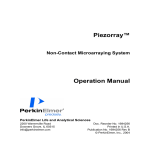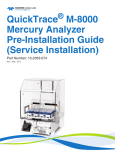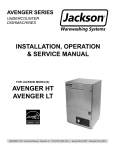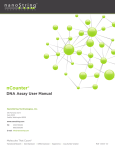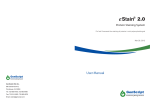Download hydrideICP Hydride Generation System User
Transcript
Elemental Scientific HG-MP2-4-A hydrideICP Generation System hydrideICP Hydride Generation System User Manual MP2 hydrideICP Generation System Elemental Scientific 1500 North 24th Street Omaha, NE 68110 USA Phone: 1.402.991.7800 Fax: 1.402.991.7799 Email: [email protected] Web: www.icpms.com 1 Elemental Scientific 1 Instructions The ESI hydrideICP Generation System is used to concentrate hydride forming elements before analysis with an ICP based spectrometer. By increasing the concentration, the sensitivity of the ICP spectrometer increase for these elements. This manual explains the use and setup of the ESI hydrideICP Hydride Generation system. Parts Included with the ESI hydrideICP Hydride Generation System: • • • • • • • • • • • • • • • • • • • • • • 1 quartz Hydride Separation Chamber (assembled) 1 PFA Hydride Mixing Tee (assembled) 1 mounting bracket (assembled) 1 Bag of Black-Black Tygon tubing 1 Bag of Orange-Yellow Tygon tubing 1 Bag of Orange-Green Tygon tubing 1 Bag of Blue-Yellow Tygon tubing 2 CTFE cups (pre-assembled) 3 M5X10 PEAK mounting screws (pre-assembled) 4 Teflon Coated M3X10 Mounting Screws (pre-assembled) 4 SBR Rubber Feet (pre-assembled) 6 Barbed Male Unions 1 Barbed Female Union 1 Yellow Capillary Connection Line 1 Blue Capillary Connection Line 1 Argon Gas Line Kit 1 1/4-28 Nebulizer Nut Adapter 1 4-Channel MP2 Peristaltic Pump(assembled) 3 Sample Probes ESI SC Software USB Peripump Communication Cable MP2 Power Cable With Adapters 2 Elemental Scientific 2 Hardware Assembly of ESI hydrideICP Generation System Should repairs need to be made to the hydrideICP Hydride Generation System, an exploded view of the assembly is shown in the following diagram. All screws have Phillips heads. Diagram 1. Exploded view of the hydrideICP Generation System 3 Elemental Scientific 3 Assembly of hydrideICP Generation System Assembly of the hydrideICP Generation System is easy. All the needed tubing and connectors are supplied with the unit. The next page provides a line diagram illustrating how to connect the system up to an ICP spectrometer. HG-0317-1300 HG-0317-0800 Hydride Generator Sample Gas In ES-4399-3001-54 Sample Gas Kit ES-4397-3152 3stop Yel/Blu Peripump Tubing ES-4397-3051 3stop Org/Yel Peripump Tubing Male Union 3X ES-4397-3038 3stop Org/Grn Peripump Tubing ES-4397-3076 3stop Blk/Blk Peripump Tubing SC-5037-3500-100 Red - 0.15mm id Purple - 0.20mm id Green - 0.25mm id Yellow - 0.30mm id Orange - 0.50mm id Blue - 0.80mm id Gray - 1.00mm id HCl Probe SC-5037-3500-100 Male Union x3 SC-5037-3500-100 Hydride Tee NaBH4 Probe Sample Probe Diagram 2. Continuous Hydride Line Diagram Assembly Notes: • • • Follow the line diagram exactly – interchanging the acid, reductant, or sample lines can lead to less hydride being created and decreased sensitivity. Do not cut the extra tubing on the yellow capillary tubing line – this extra line is important for properly using the Hydride Separation Chamber. Running the hydride gas into a spray chamber is recommended to increase stability without reducing sensitivity. ! IMPORTANT!! Additional reaction may occur in the waste line after exiting the Hydride Separation Chamber, creating toxic arsine, stibine, and hydrogen selenide gas. Ventilate the drain outflow area!! 4 Elemental Scientific Diagram 3. How to properly connect the hydrideICP for use with a FAST valve. The diagram to properly connect the hydrideICP for use with a FAST valve is shown above. 5 Elemental Scientific 4 MP2 and Pump Tubing Assembly The hydrideICP ships with a four channel MP2 micro-peristaltic pump. This pump is used to draw the sample, acid, and reductant into the reaction tee. The pump is also used to draw the waste liquids out of the Hydride Separation Chamber. It is recommended that the tubing be installed on the MP2 as follows: Step 1. Place one end of the yellow-blue tubing on the female barbed union. Attach the yellow-blue tubing to the MP2 (clockwise) and connect the other end of the tubing to a drain line for the removal of excess reactants from the Hydride Separation Chamber. Step 2. Place one end of the black-black tubing to the bottom barbed male union (SAMPLE) on the Reaction Tee and mount the tubing to the MP2 (counterclockwise). Attach the free end of the tubing to a probe. The probe will be placed in the sample to be analyzed. Step 3. Attach one end of the orange-green tubing to the middle barbed male union (ACID) on the Reaction Tee. Mount the tubing to the MP2 (counterclockwise) and attach a probe to free end of the tubing. This probe will be placed in the Acid Blank solution. Step 4. Attach one end of the orange-yellow tubing to the top barbed male union (REDUCER). Mount the tubing to the MP2 (counterclockwise) and attach a probe to the free end of the tubing. This probe will be placed in the Reductant solution. 6 Elemental Scientific The entire set-up should look like the following photo. Reductant Line (orange-yellow) Acid Line (orange-green) Sample Line (black-black) Drain Line (blue-yellow) The tubing should be mounted to the MP2 in the following order: Top channel – Orange-yellow tubing (reductant) Second Channel – Orange-green tubing (acid) Third Channel – Black-black tubing (sample) Bottom Channel – Yellow-blue tubing (drain) Note: The yellow-blue (drain) tubing should be placed in the MP2 in the opposite direction of the other tubing. The flow rates of each size of tubing are as follows: Acid channel – Orange-Green: 4.7μL/min per RPM Reductant channel – Orange-Yellow: 9.5μL/min per RPM Sample Channel – Black-Black: 19μL/min per RPM Drain channel – Yellow-Blue: 51μL/min per RPM After installing the tubing, the plungers on the MP2 may need to be adjusted for optimal pumping. 7 Elemental Scientific 5 Using the hydrideICP with the FAST System This section of the manual will show how to properly use the hydrideICP with an ESI autosampler and FAST system. Step 1. With the ESI autosampler powered on, connect the 5 pin Limo cable from the MP2 into P1 on the ESI autosampler and turn on the power to the pump. A green LED should light to verify that the pump is now on. Step 2. Initialize the autosampler. This will allow the ESI SC software to communicate with the newly attached MP2. Step 3. After initialization is complete click on the FAST tab of the SC software as shown. 8 Elemental Scientific Step 4. While in the FAST window make sure that the “Enable FAST Control” box is selected. Step 5. While still in the FAST window, click the “File” button and select “Open Text File”. Step 6. Select the file named “hydrideICP FAST – 2 mL Loop” as the file to run under FAST control. 9 Elemental Scientific Step 7. The FAST method shown below should now be loaded into the FAST control window. Under the “Peripump” tab change the tubing color to Black-Black. This is the tubing size of the carrier and is the speed with which the sample will be pushed from the loop and into the hydrideICP’s Gas Liquid Separator (GLS). 10 Elemental Scientific Loop Size for FAST with hydrideICP Analysis To correctly set up the hydrideICP for use with the FAST system the estimated analysis time must be determined from the ICP or ICP-MS method being used. The default loop size for the “hydrideICP FAST – 2mL Loop.txt” method is 2 mL. The default pump speed in the “hydrideICP FAST – 2 mL Loop” is 100 rpm. This equates to a 1.87 mL/min flow rate for the sample through the loop and into the GLS. Using this peripump speed and a 2 mL sample loop, the total time that sample will be entering the GLS would be 64 seconds (2 mL/(1.87mL/min). With a sample flush time of 25 seconds, there is approximately 45 seconds of analysis time. If more time is needed for analysis there are two options. 1.) Decrease the speed of the MP2 in the FAST method. Decreasing the MP2 speed to 50 RPM will double the analysis time to 90 seconds, but this will also cut the signal to ½ of the 100 RPM signal. To change the MP2 speed in the FAST method, change the value of Peripump1 in the parameters column to “50” from “100”. 2.) The size of the sample loop can be increased. At 100 RPM a 3 mL sample loop will give approximately 30 seconds more of analysis time than a 2 mL loop, increasing measurement time from 45 seconds to 75 seconds. If the sample loop is to be increased the FAST method must be edited. If it is decided that the loop size is to be increased the time parameter for “Timer A” will need to be increased for a larger sample loop. Shown below is a table comparing the estimated measurement time with corresponding loop sizes and the necessary load time for that size loop. 11 Elemental Scientific 100 RPM MP2 Speed Estimated Measurement Time (s) Loop Size (mL) FAST Method Timer A (s) 0 - 15 1 5 15 - 30 1.5 6 30 - 45 2 8 45 - 60 2.5 10 60 - 75 3 12 75 - 105 4 16 75 RPM MP2 Speed Estimated Measurement Time (s) Loop Size (mL) FAST Method Timer A (s) 0 - 20 1 5 20 - 40 1.5 6 40 - 60 2 8 60 - 80 2.5 10 80 - 100 3 12 100 - 120 4 16 50 RPM MP2 Speed Estimated Measurement Time (s) Loop Size (mL) FAST Method Timer A (s) 0 - 40 1 5 40 - 70 1.5 6 70 - 100 2 8 100 - 130 2.5 10 130 - 160 3 12 160 - 420 4 16 12 Elemental Scientific 6 Use and Optimization of the hydrideICP Generation System Peristaltic Pump Speed The MP2 peristaltic pump is used to pump all liquid reagents into the Hydride Separation Chamber. The speed of the pump controls three important parameters: • Sample and reagent usage – The faster the pump runs the faster the sample and reagents are used up. A slow pump speed will increase the length of time the analysis can run without exhausting the sample or reagent supplies • Sensitivity – The speed of the pump directly correlates to the rate of hydride generation. The faster the pump runs the more hydride is generated and the greater sensitivity. • Flush time – The faster the pump runs, the faster the Hydride Separation Chamber and Reaction Tee are flushed of the previous runs analytes. It is recommended to run the pump in the range from 50-150 rpm. This range presents a linear increase in signal with increase in rpm. The range above 150 rpm provides only slightly increased signal for the increase in rpm. However, any RPM can be used to optimize desired performance parameters. Nebulizer Gas Flow The argon gas flow from the ICP unit to the Hydride Separation Chamber is another important parameter for the performance of the hydrideICP. A low gas flow allows time for the gaseous hydrides to be formed. It is recommended that the Nebulizer gas flow be set in the range of .2-.3 L/min. Lower gas flow rates may be achievable, but the stability of the signal usually suffers, while higher gas flow rates will decrease sensitivity. It is important to note that the gas flow rate that optimizes both sensitivity and stability may not be in the .2-.3 L/min. range for all possible setups, but it is a good starting point for optimization. Washout To clean the Hydride Separation Chamber, place the sample probe in de-ionized water and rinse for 4 minutes between samples. 13 Elemental Scientific 7 Reagent Solutions Summary of Hydride Generation The hydride forming elements present in an analyzed sample will react with Sodium Borohydride to form gaseous hydrides. These hydrides exit the Hydride Separation Chamber and are carried into the ICP spectrometer by Argon gas from the ICP unit. Warnings: Sodium Borohydride is unstable in water, giving off hydrogen gas. Store any solution of Sodium Borohydride in a vented container. Take care when handling Sodium Boroydride as it can cause burns to the skin and respiratory issues. Take care when handling Stannous Chloride as it is a skin and eye irritant. Take care when handling Hydrochloric Acid as it can cause severe burns. Acid Blank Reagent A solution of 50% concentrated hydrochloric acid, 50% de-ionized water by volume is used to facilitate the hydride reaction. This solution is what will be added to the middle section of the reaction tee. Sodium Borohydride Sodium borohydride is used as the reducing agent in the hydride reaction. It is recommended that a solution of 0.5% m/v sodium borohydride (NaBH4) with 0.5% m/v sodium hydroxide be used to analyze hydrides. The sodium hydroxide is used to stabilize the borohydride in solution. It is recommended that the sodium borohydride solution be prepared immediately before use for each day of analysis, but if stored at 4°C the solution may be used over the course of a few days. Stannous Chloride Stannous Chloride is used as the reducing agent when attempting to analyze only mercury with the hydrideICP. It is recommended that the solution be composed of. 0.1 - 10% m/v of stannous chloride (SnCl2) in 1 - 10% v/v hydrochloric acid. Note that stannous chloride will only work with ionic mercury solutions. 8 Sampling and Analyte Preparation Here are a few tips before beginning analysis: • • • Before analysis, samples require acid digestion to ensure that all hydride forming elements are in their proper state to be analyzed. The sample(s) to be analyzed by the hydrideICP need to be presented in solution with hydrochloric or nitric acid. It is recommended that the carrier solution be 10% acid v/v. The achievable sensitivity from the hydrideICP is also affected by the oxidation state of the hydride forming elements in the sample. As, Sb, Se and Te all have different states of oxidation. To reduce As and Sb to their lowest oxidation state a mixture of potassium iodide and ascorbic acid. Te and Se can be reduced by boiling the sample in 6M hydrochloric acid for 10 minutes. Transition metals may interfere with the hydride reduction reaction. 14 Elemental Scientific 9 Re-order Part Numbers Yellow-blue Peristaltic Tubing – ES-4398-3076 Orange-yellow Peristaltic Tubing – ES-4397-3051 Orange-green Peristaltic Tubing – ES-4397-3038 Black-black Peristaltic Tubing – ES-4398-3076 Barbed Male Unions – ES-2501-PPM1 Barbed Female Unions – ES-2501-PPF1 Elemental Scientific 1500 North 24th Street Omaha, NE 68110 USA Phone: 1.402.991.7800 Fax: 1.402.991.7799 Email: [email protected] Web: www.icpms.com 15















